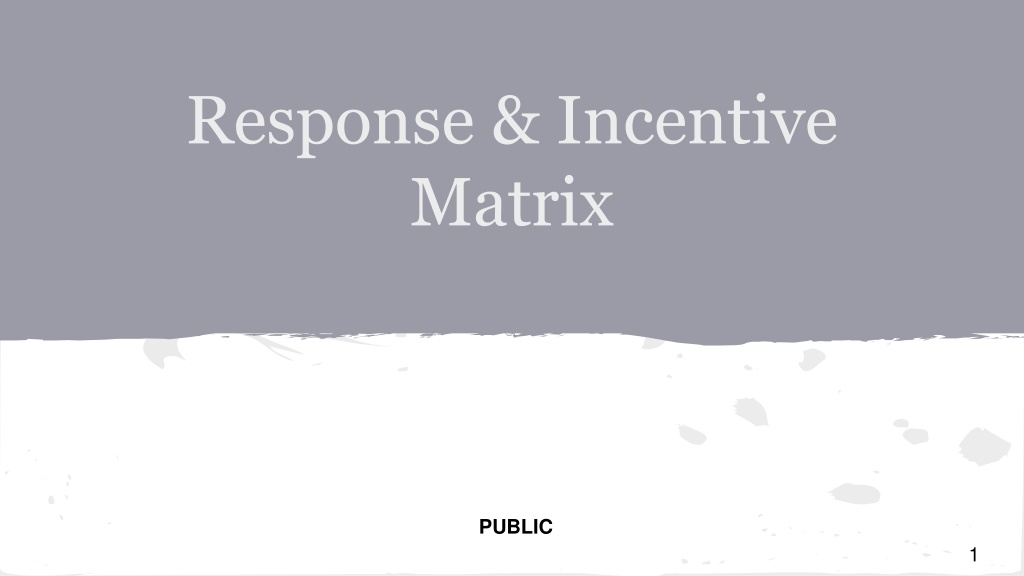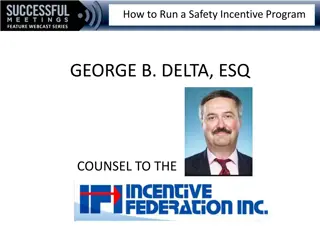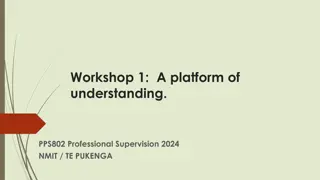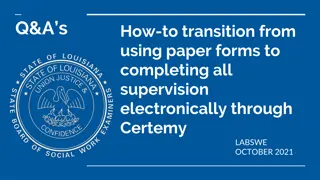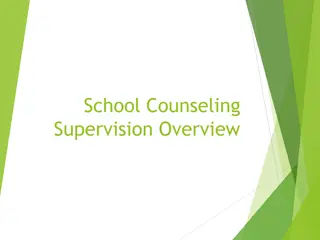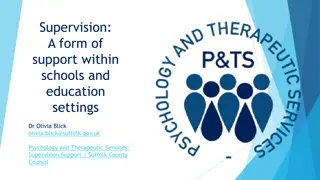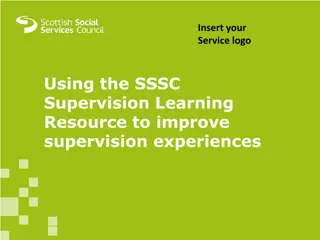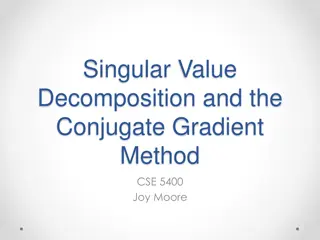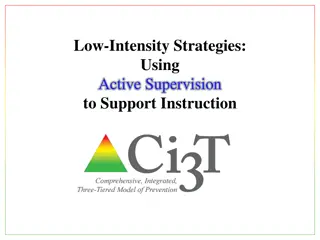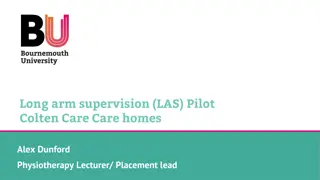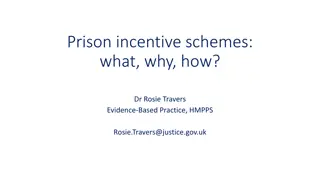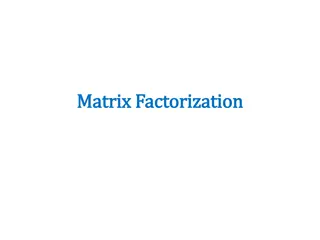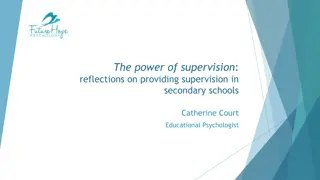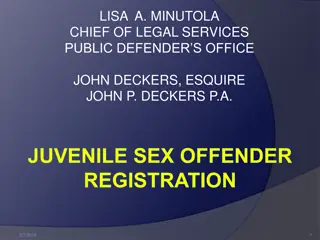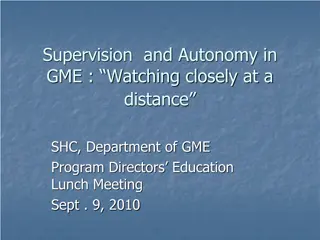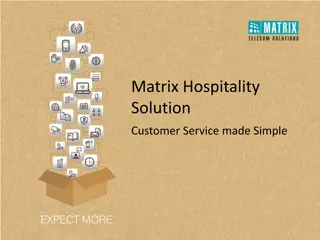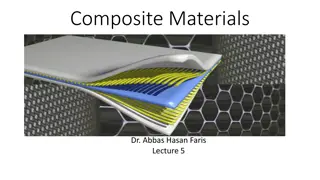Enhanced Offender Supervision Through Response & Incentive Matrix
The Response & Incentive Matrix (RIM) aims to provide offenders with fair incentives and violation responses, reducing judicial involvement. It includes tables for incentives and responses based on offender actions. Implementation of RIM leads to consistent actions, immediate rewards, positive behavior reinforcement, and cost savings within the judicial system.
Download Presentation

Please find below an Image/Link to download the presentation.
The content on the website is provided AS IS for your information and personal use only. It may not be sold, licensed, or shared on other websites without obtaining consent from the author. Download presentation by click this link. If you encounter any issues during the download, it is possible that the publisher has removed the file from their server.
E N D
Presentation Transcript
Response & Incentive Matrix PUBLIC 1
Reason For the Matrix The purpose of the matrix is to provide offenders with swift, sure and fair incentives and violation responses and to identify the circumstances requiring judicial involvement. The matrix has: A table for incentives A table for violation responses Each table includes three levels (the level is dependent upon the violation severity or the accomplishments of the offender) 2
Benefits Of the Matrix Consistent and progressive accomplishment and violation responses Immediate reward of accomplishments and handling of technical violations Reinforcement of positive behavior Reduction of Order to Show Cause affidavits or other requests submitted to judicial partners Monetary savings for judicial system Fewer order to show cause hearings Less legal preparation 3
How Does An Offender Get Placed In RIM? Effective October 1, 2015 all offenders will be supervised under RIM RIM will be a standard condition for probation and parole All offenders will be required to sign a new agreement adding RIM as a standard condition 4
Probation & Parole Condition The supervision condition for the the program will be worded and ordered as follows: "Abide by the Response & Incentive Matrix 5
Incentives Based on Low, Moderate, High/Intensive risk to recidivate level from primary assessment Goal is a 4:1 ratio incentive-to-violation response APPA: Effective Responses to Offender Behavior: Lessons Learned for Probation and Parole Supervision 2. Apply Proper Ratio of Incentives to Sanctions While some research supports the ratio of four incentives for every one sanction that is imposed for a violation of supervision (see report for citations), further experimental research is needed to validate this ratio. In practice, the best rule of thumb is to use incentives at least as frequently as sanctions are used. Sanctions can range from verbal corrective action to brief periods of incarceration. There also should be a wide range of incentive options that supervision officers may use to promote compliance among probationers and parolees. The offender has the option to choose from the available incentives within their level We are striving to determine ways to connect the positive behavior with a reward that makes sense to the offender. 7
Violation Response Based on Low, Moderate, High/Intensive risk to recidivate level from primary assessment Used for all violations of supervision conditions 8
Violation Response Where a single event results in multiple violations, the probation or parole officer should administer a single response based on the most severe violation Jail stays of 1, 2 and 3 days (RIM jail commitments) may be used as a violation response with prior approval. They shall not exceed five (5) days in a 30 day period. 9
Matrix Deviations If circumstances indicate an immediate or potential threat to public safety or the circumstances of a particular violation are not appropriately addressed by the matrix, the response matrix should not be used and the court/Board of Pardons & Parole should be notified. The case must be immediately staffed with a supervisor and a 72-Hold should be utilized in cases of public safety. A violation report must be filed with the court/Board of Pardons & Parole in which the probation or parole officer clearly and specifically articulates the rationale for deviating from the matrix. 10
Earned Time and Earned Compliance Credits PUBLIC 12
Earned Time Program - Prison Minimum of 4 months off prison sentence for successful completion of qualifying evidence based programs tied to the inmate's Case Action Plan Programs which qualify: High School Diploma Vocational Certificate Substance Abuse Treatment Sex Offender Treatment The Earned Time Program is not available to inmates with a life without parole sentence, or if the Board has issued an expire life sentence decision 13
Example Take the example of John Doe. He has sex offender treatment as his #1 CAP priority, substance abuse treatment as #3, and he decides to enroll in a vocational trade class at the prison. He would be entitled to at least 4 months off his prison sentence for completing SOTP. He would also be entitled to at least 4 months off for completing SATP. But if he also completes a vocational certificate, it would be entirely up to the Board of Pardons & Parole whether he receives more time off his sentence. 14
Earned Compliance Credits - AP&P Offenders on probation and parole can earn time credits for compliance with the terms of probation and parole. One month credit for each month violation free can be earned Once earned the offender retains the credit The Utah Department of Corrections will maintain an Earned Compliance Calculator within the database that will track the Potential Earned Compliance Termination Date. 15
Earned Compliance Credits Essentially, there are three ways to complete supervision early: 1. avoid violations of supervision in order to earn compliance credits, 2. actively participate in evidence based programs to meet the treatment dosage recommendations, 3. reduce risk factors by actively engaging in the Case Action Plan. 16
Q. What needs to be done to get the offender started on RIM? A. Discuss the new RIM condition with the offender Explain the matrix (incentives and sanctions) Explain Earned Compliance Credits Give the offender a copy (paper or digital) of the matrix Have the offender sign a new new probation and/or parole agreement with RIM listed as a standard condition 18
Agreements 19
Q. the RIM? Beginning October 1st are all offenders grandfathered into A. subject to RIM. In order to ensure offender s understand and have reviewed the condition a new agreement is necessary. Yes and no. Everyone under supervision as of October 1, 2015 will be Q. added as a special condition during the pilot is it still necessary to have them sign ANOTHER agreement? If the offender has already signed a waiver and had RIM A. Yes. A new agreement needs to be signed. 20
Q. sign a new PA to add this to their conditions without them signing a waiver agreeing to add it? I understand it will become a standard condition, however I can t see how we can legally force them to sign a new PA. How can we force people who are already out on parole to A. There is no waiver signing process for this condition. Q. agreement? A. still refuse to sign involve your supervisor and notify the court and/or BOPP. What do we do if an offender refuses to sign the new Explore their concerns and help the offender understand RIM. If they 21
Reports 22
Q. When And How Will The Responses And Incentives Be Reported? A. the Court / BOPP when a report is submitted under a re-titled header Offender History / Response & Incentive Matrix Date Type Incentive or Response Description of Violation/Accomplishment Description of Response Example: Date Incentive/Response Outcome 1/15/2015 Level 2 - Response Positive Drug Use TRC 12/1/2014 Level 1 - Incentive Community Service Eliminate Curfew Ordered as they occurred with the most recent at the top Responses and incentive history will be included in all transfer summaries and reported to Accomplishment/Violation 23
Q. Will the history be included in the reports F-Track generates? A. easily copied format will be available by December 1, 2015. Efforts to include the history in the report templates will be pursued thereafter. Eventually. For now it is necessary to compile it. Our hope is an 24
Incentives 25
Q. Why the goal of a 4:1 incentive to sanction response ratio? A. graph on the next slide. Research is indicating this ratio appears to be the sweet spot. See the 26
Q. off the original amount or the current amount? Is the amount off on a reduction of community service hours A. Off the original for the first and every subsequent reductions. 28
Q. purchasing? How should our office track the incentive disbursement and A. purchasing, inventory and disbursement of awards and vouchers. A template is available. Each office is required to have a system in place to track the Q. to be given to the offenders? A. The division is exploring options for purchasing incentives within purchasing rules. Vouchers can be obtained through non-profit organizations. How is the department paying for the rewards that are going 29
Q. supervision fee monthly, and only makes a $30.00 payment would that count against them as far as the good time is concerned? If an offender is ordered to pay restitution, fines, and a A. violation is entered into the allegation/response screens in F-Track during that month. If the agent determines the offender is in violation and documents the violation no credits will be earned. Earned Compliance Credits do not accrue for any given month if any Q. are in jail pending a new felony or serving a sentence for a new conviction that violated the terms of their original probation/parole? A. Credits are not earned while incarcerated for stays of six days or more. How will probation compliance credit be calculated if they 31
Responses 32
Q. Is a Matrix Commitment The Same As A 72 Hour Hold? A. No. There is a difference 72 Hour Hold Used to investigate a serious violation or to obtain a BOPP or Court warrant. This excludes weekends or holidays. Matrix Commitment Level 3 response which results in a 1,2 or a 3 day jail stay. Maximum of 5 days jail per 30 days. These are actual days and include weekends and holidays. Approval by the court or BOPP is required. 33
RIM JAIL COMMITMENT PROCESS PAROLE Agent prepares standard Parole Progress/Violation Report including the offender s RIM History and include: Type RIM JAIL COMMITMENT beneath the header Request a jail commitment in your recommendation. Identify number of days requested and the jail where the offender is to be committed DURING BUSINESS HOURS Submit the report via UDOCA using the normal process Call BOPP at 801-261-6464 and tell them the request has been entered so they can expedite it 34
RIM JAIL COMMITMENT PROCESS PAROLE AFTER BUSINESS HOURS Call BOPP at 801-261-6464 and determine who the on-call Board member is. Call the on-call BOPP member and follow their instructions for submitting the PV for their review Once a signature is obtained the agent will then print the report with the approving signature and take the offender to the jail for booking. 35
RIM JAIL COMMITMENT PROCESS PROBATION Agent prepares standard Progress/Violation Report including the offender s RIM History and include: Type RIM JAIL COMMITMENT beneath the header Request a jail commitment in your recommendation. Identify number of days requested and the jail where the offender is to be committed SUBMISSION This process may vary from district to district. Contact your local court administrator for details. An example of how the 2nd District has set up their protocol is included on the follow slide: 36
RIM JAIL COMMITMENT PROCESS PROBATION RIM Jail Commitment requests will NOT be sent through court services in the same way our normal PV and PSI reports are sent. The PV is sent to a designated court email address with a cc: to the sending agent and the agent s supervisor. Emails will state URGENT RIM JAIL COMMITMENT REQUEST in the subject line. Ogden District Court: 2webermorgand@utcourts.gov The assigned clerk who monitors this email will print our report and attempt to locate the judge who sentenced the offender to probation and obtain his signature. In the event the sentencing judge is not available, this will be submitted to any other available judge for signature. Once a signature is obtained the clerk will scan the signed report and email it back to the agent and supervisor. Agents will then print the PV with approving signature and take a copy to the jail when booking the offender. 37
Q. Matrix Commitment? What Should We Consider When Placing An Offender On A A. Medical Very sick offenders with special medical needs and/or medications should be screened with a supervisor and your jail representative prior to placement on a matrix commitment. Weekends Weekends are a busy time for the jails. Be mindful of this if it is an issue at your jail. 38
Q. recommendation is approved for that jail as we have done in the pilot? Will the jails take offenders from other districts/jails if the A. us know. Our understanding is yes. If something different happens, please let Q. each judge if the offender has multiple cases? Do we need to submit a RIM jail commitment request to A. serious offense and send the request to that court. No. If there are different districts/courts involved pick the most 39
Q. RIM commitments? Will the jails be reimbursed for the offenders we place on A. be distributed if there is money remaining in the jail contract. It is our understanding reimbursement for RIM jail commitments can 40
Q. with RIM? How do we handle offender s who are on zero tolerance A. based on RIM. Notify the court on every violation. Frame your recommendation Note to Agents: Never recommend zero tolerance. It goes counter to the Justice Reform Initiative. 41
Q. Restarted/Continued? What Happens If Parole & Probation is A. matrix at the base level for their risk level. The offender is re-assessed (LSI, WRNA etc.) and starts anew on the 42
Q. different stages? What if an offender has probation and/or parole cases at A. Use the highest level of response and award all incentives 43
Q. Reward An Offender At The Same Time? What If It Is Necessary To Respond to a Violation and A. Do both! Respond to the violation and provide the incentive. 44
Matrix 45
Q. and has the new system been piloted? Why such a drastic change from the pilot to the new system A. received indicated the need for a more direct and less confusing matrix. The new matrix has not been piloted but the opportunity to modify it will occur as needed when the sentencing guidelines are up for review. The purpose of the pilot was to evaluate the matrix. Feedback 46
Q. can be accessed? Is there any other training or quick reference guide which A. Another options is: The 2015 Adult Sentencing and Release Guideline is available at http://www.utah.gov/pmn/files/172049.pdf 48
Q. DUI s? Does the new push to terminate LOW risk offenders apply to A. felony DUI s. Our belief is the courts can still place them on court probation or an alternative form of supervision. There could be some modifications to this statute this year. Yes, but there is a statutory mandate for no early terminations on 49
Q. offender? What is the recommended way to share the matrix with the A. Email it to the offender 50
